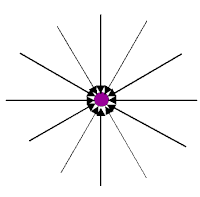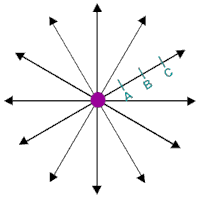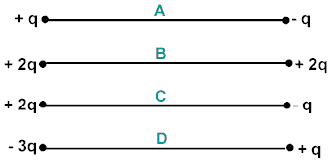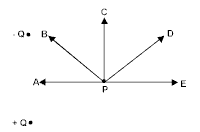| 1 |
How is the direction of electric
field lines defined?
|
|
| 2 |
Is the central "parent" charge in the following diagram positive or negative?
|
|
| 3 |
|
|
| 4 |
How do the field strengths compare at points B and C? [C is three times the distance from
the central charge as is A]
|
|
| 5 |
If the central charge is +3 mC, and point B is 2 meters away,
what is the magnitude of the electric field strength at point B?
|
|
| 6 |
What magnitude force would an electron placed at point B experience?
|
|
| 7 |
Would a free proton placed at
point B naturally move towards A or towards C?

|
|
| 8 |
Are the charges shown equal in magnitude? the same sign? |
|
| 9 |
If each charge group is temporarily connected with a conducting wire. In which
system will the residual charge on each sphere be + ½ q?
|
|
| 10 |
A point charge Q1 exerts an electrostatic force F on a second point charge Q2
which is 5 cm away. If the charges are then placed 10 cm apart, that magnitude of
the electrostatic force Q1 exerts on Q2 will be?
|
|
| 11 |
Three identical metal balls are mounted on insultated rods. Ball A has a charge of
+q, while balls B and C are uncharged. Ball A is brought into contact momentarily
with ball B, and then with ball C. At the end of this experiment, the charge on ball
A is
|
|
| 12 |
The electric field intensity is zero at the midpoint of which group of charges?
|
|
| 13 |
In which group of charges is the attractive force at the midpoint the greatest ? [let the
distance between each set of charges be 2r]
|
|
| 14 |
What does it mean to say that an electric field is "radial?" If the field lines
in an electric field are parallel to each other, what does this tell you about the
electric field strength in that region?
|
|
| 15 |
Describe what an electric field looks like between two charges of opposite sign?
|
|
| 16 |
Which arrow represents the direction of the electric field at point P due to the
stationary charges +Q and -Q? 
|
|
| 17 |
Describe what an electric field looks like between two charges of the same sign?
|
|
| 18 |
Which of the four field patterns shown represents a possible electrostatic field? |
|
| 19 |
What does a volt measure? At what angle do equipotential surfaces meet field lines?
|
|
| 20 |
What is the definition of the
absolute potential at infinity?
|
|
| 21 |
In which charge configuration are both net E and net V nonzero at the center of the
equilateral triangle? |
|
| 22 |
How do field lines indicate where the strength of a field is greatest? How do
equipotential surfaces indicate where the strength of a field is greatest?
|
|
| 23 |
|
|
| 24 |
In which charge group(s) is the voltage at the midpoint equal to zero? How much work
would be required to move a proton from infinity and place it on the midpoint of each
charge group? [let the distance between each set of charges be 2r]
|
|
| 25 |
How do the absolute potentials numerically compare between points B and C? 
|
|
| 26 |
If a positive test charge moves in the direction of a field line, does its EPE increase or
decrease?
|
|
| 27 |
Two test charges are brought from
infinity into the vicinity of a sphere of charge +Q. The first test charge, +q, is
brought to point A; the second test charge, +2q, is also brought to point A.
Compared with the electrostatic potential of +q, the electrostatic potential of +2q
is (smaller, the same, greater). |
|
| 28 |
Two test charges are brought from
infinity into the vicinity of a sphere of charge +Q. The first test charge, +q, is
brought to point A; the second test charge, +2q, is brought to point B. Compared
with the electrostatic potential energy of the +q test charge at A, the electrostatic
potential energy of the +2q test charge at B is (smaller, the same, greater). |
|
| 29 |
Two test charges are brought from
infinity into the vicinity of a sphere of charge +Q. The first test charge, +q, is
brought to point B; the second test charge, -q, is also brought to point B. Compared
with the electrostatic potential energy of the +q test charge at B, the electrostatic
potential energy of the -q test charge at B is (smaller, the same, greater). |
|
| 30 |
For a positive point charge, how do the graphs of E vs r and Vabs vs r compare?
|
|

